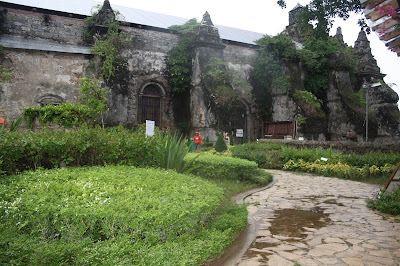Ilocos Norte is one of the provinces we visited in our North Luzon Escapades. Like Vigan, Ilocos
Norte is one of the most beautiful and historic places in the Philippines. Paoay Church, formally
called St. Augustine Catholic Parish Church, is the must-see tourist spot in Ilocos Norte. It is truly a national treasure of
Ilocos and is considered as one of the oldest church in the Philippines. Paoay Church was awarded in 1993 as UNESCO world heritage site. It is a prime example of a
baroque church, in which, the bell tower is physically separated from the
church. The church was built by the Augustinian friars in 1694 and was completed in 1894. It is made of coral blocks and bricks that incorporates gothic, baroque and oriental designs that add up to its striking appeal. Like St. Paul Cathedral of Vigan, it is built to withstand earthquakes. It has 24 carved buttresses that support the church's structure during earthquakes.
It is made of coral blocks and brick that incorporates Gothic, Baroque and Oriental designs that add up to its striking appeal.
- See more at: http://www.pinoyadventurista.com/2011/06/paoay-church-unesco-world-heritage-site.html#sthash.xvQLZluh.dpuf
- See more at: http://www.pinoyadventurista.com/2011/06/paoay-church-unesco-world-heritage-site.html#sthash.xvQLZluh.dpuf
It is made of coral blocks and brick that incorporates Gothic, Baroque and Oriental designs that add up to its striking appeal.
- See more at: http://www.pinoyadventurista.com/2011/06/paoay-church-unesco-world-heritage-site.html#sthash.xvQLZluh.dpuf
- See more at: http://www.pinoyadventurista.com/2011/06/paoay-church-unesco-world-heritage-site.html#sthash.xvQLZluh.dpuf
It is made of coral blocks and brick that incorporates Gothic, Baroque and Oriental designs that add up to its striking appeal.
- See more at: http://www.pinoyadventurista.com/2011/06/paoay-church-unesco-world-heritage-site.html#sthash.xvQLZluh.dpuf
- See more at: http://www.pinoyadventurista.com/2011/06/paoay-church-unesco-world-heritage-site.html#sthash.xvQLZluh.dpuf
 |
| Paoay Church, also known as the St. Augustine Catholic Parish Church |
 |
| Paoay Church and the bell tower on its left side |
 |
| It was raining when we visited there |
 |
| The whole gang with a big smile on our faces despite the rain |
 |
| .....and more big smile |
 |
| A close shot of one of the oldest church in the Philippines |
 | |||||||
|
 |
| The bell tower, which is separated from the church |
 |
| In front of the church |
 |
| A shot taken from the street |
 |
| A shot taken from the street |
 |
| The altar |
 |
| The altar |
 |
| Picture taken from the front door |
 |
| Another shot of the altar |
 | ||||||||||
| Stolen shot...my brother, Bowie |
 | ||
The church by night
|
 |
| The bell tower by night |
Right behind it, is the “Jardin de San Agustin”, a prayer garden for
churchgoers and visitors. I’ve
got goosebumps when I walked in this garden, probably because of the atmosphere
– it was raining a little, nobody was there but me and the statues of saints
and all those green plants and flowers and man-made fountains - I should have
waited my brother and sisters - and not left them in the church. As I was walking
along the garden path, I read all the biblical quotes scattered along the
beautiful landscaped garden and somehow I was into it and I felt like I was
stepping into the old times when the monks and nuns were in the same place
praying and meditating. It was so quiet and so solemn. I felt like I was
disturbing them with the sounds / clicks of my camera. Whatever it was that got
into me, it scared me that I almost run but then, I saw my brother coming.
 |
| Signboard...to the prayer garden |
 |
| On the right side of the pathway |
 |
| A garden pathway |
 |
| The prayer garden is just next to the Paoay Church, on the left side just behind the detached bell tower |
 |
| A prayer garden path |
 |
| The buttresses of the church is so visible in this pic |
 |
| The side window and wall of the Paoay Church |
 |
| The buttresses of the church is so visible in this pic |
 |
| ...and also from here |
 |
| Plants...and plants...and plants |
 |
| The buttresses of the church is so visible in this pic |
 | |
| Statue of a little boy or saint? |
 |
| Statue of a saint |
 |
| The cross with a hanging plants around it |
 |
| The bell tower and the side of the church is visible in this pic |
 |
| A pathway going to the side door of Paoay Church |
 |
 |
| One of the biblical quotes |
 |
| Garden landscape |
 |
| The side wall of the church |
 |
| A pathway going to the side door of Paoay Church |
 |
| Taken near the gift shop |
 |
| Taken near the gift shop...from different angle |
 |
| Greens |
 |
| ....and more greener |
 |
| They just came to the garden when I have already finished my rounds of the entire garden |
For more info, please check this link.....https://en.wikipedia.org/wiki/Paoay_Church
































































